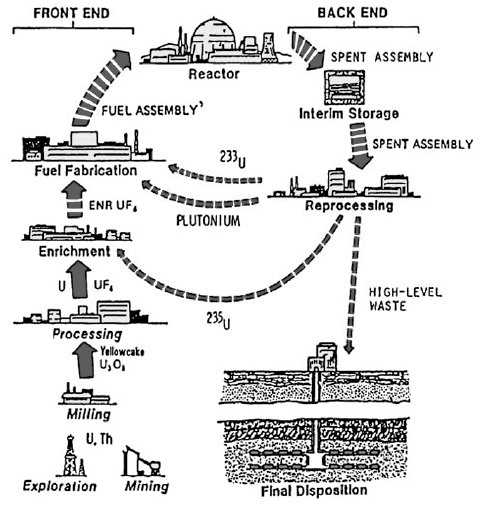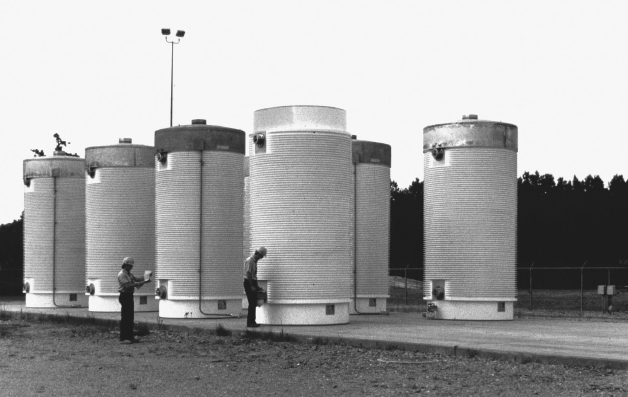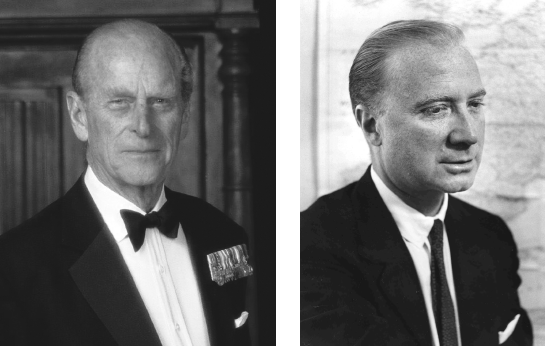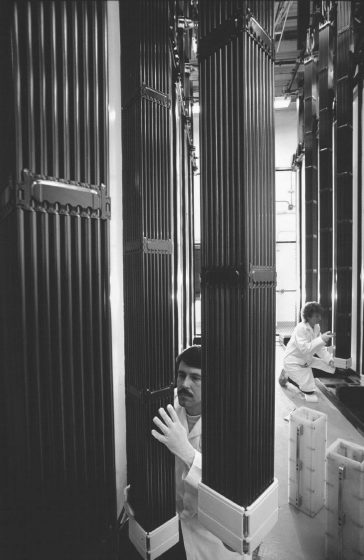|

by Marjorie Mazel Hecht
February 13, 2009
from
21stCenturyScienceTech Website
There’s no such thing as nuclear waste!
This nasty term was invented just to
stop the development of civilian nuclear power.
The spent fuel from nuclear power plants is actually a precious
resource: About 96% of it can be recycled into new nuclear fuel. No
other fuel source can make this claim—wood, coal, oil, or gas. Once
these fuels are burned, all that’s left is some ash or airborne
pollutant by-products, which nuclear energy does not produce.
Thus, nuclear is a truly renewable resource. Furthermore, unlike
wind, solar, and other so-called alternative energy sources, a
nuclear fission reactor (the fast reactor or breeder reactor) can
actually create more fuel than it uses up.
In the Atoms for Peace days of the 1950s and 1960s, it was
assumed that spent reactor fuel would be reprocessed into new
reactor fuel. The initial plan was for the United States and other
nuclear nations to have closed nuclear fuel cycles, not
“once-through” cycles. In the closed fuel cycle, uranium is mined,
enriched, and processed into fuel rods; then it is burned as fuel
and reprocessed, to start the cycle again. 1
1. See “The
Beauty of the Nuclear Fuel Cycle,” 21st Century Science &
Technology, Winter 2005-2006
“Burying” spent fuel (as planned for Yucca Mountain) was not in the
Atoms for Peace picture. Why bury a fuel source that could
provide thousands of metric tons of uranium-238, fissile
uranium-235, and plutonium-239 that could be used to make new
reactor fuel?
But, as explained below, the U.S. stopped its reprocessing program
in the 1970s and instead now stores spent nuclear fuel, waiting for
a long-term burial site. Despite the scary headlines, the total
amount of spent fuel in storage in the United States is small.
The U.S. Department of Energy stated in
2007:
“If we were to take all the spent
fuel produced to date in the United States and stack it
side-by-side, end-to-end, the fuel assemblies would cover an
area about the size of a football field to a depth of about five
yards.”

The closed
nuclear fuel cycle, shown here, reprocesses spent nuclear fuel to
create new reactor fuel.
Uranium is mined,
milled, converted into uranium hexafluoride, and then enriched.
Because most uranium
(99.276%) is U-238, the uranium fuel must go through a process of
enrichment,
to increase the
ratio of fissionable U-235 to the non-fissionable U-238 from about
0.7% to 3 to 4%.
The enriched uranium
is then fabricated into fuel rods for use in light water reactors.
Now, the United States has a “once through” fuel cycle, so that
spent fuel is stored in cooling pools at the reactor site,
and after it cools,
it is stored in dry casks, awaiting “burial.” What a waste!
The amount of usable fuel in that
hypothetical football field, however, is vast.
Burying 70,000 metric tons of spent
nuclear fuel would waste 66,000 metric tons of uranium-238, which
could be used to make new fuel, and an additional 1,200
metric tons of fissile uranium-235 and plutonium-239, the energetic
part of the fuel mixture. Looking at it another way, the spent fuel
produced by a single 1,000-megawatt nuclear plant over its 40-year
lifetime is equal to the energy in 5 billion gallons of oil, or 37
million tons of coal. Would you throw that away?
In addition to the multi-trillion-dollar amount of new reactor fuel
that could be recycled from 96% of the spent nuclear fuel now in
storage, the remaining 4% of so-called high-level waste—about 2,500
metric tons—is also usable.
Dr. Michael Fox, a physical
chemist and nuclear engineer, has estimated that there are about 80
tons each of cesium-137 and strontium-90 that could be separated out
for use in medical applications, such as targeted radioisotope
therapies, or sterilization of equipment.

Dry casks of spent reactor fuel, stored on a concrete pad at a
nuclear power plant.
Why not reprocess it
and burn it up?
Using isotope separation techniques, and
fast-neutron bombardment for transmutation (technologies that the
United States has refused to develop), we could separate out other
valuable radioisotopes, like
americium, which is widely used
in smoke detectors, or plutonium-238, which is used to power heart
pacemakers, as well as small reactors in space.
Krypton-85, tritium, and
promethium-147 are used in self-powered lights in remote
applications; strontium-90 is used to provide electric power
for remote weather stations, and in remote surveillance stations,
navigational aids, and defense communications systems.
Progress vs.
Malthus
To explain how a valuable resource became “waste,” it’s necessary to
look back at the world situation as Atoms for Peace was
taking off, and man was headed for the Moon. Scientific optimism and
progress were all around. Most people assumed that the next
generation would have increasing prosperity.
But after the death of Franklin Roosevelt and the resurgence
of the British imperial design, Malthus reared his ugly head.
As the first director of UNESCO (the United Nations
Educational, Scientific, and Cultural Organization) in 1945, Sir
Julian Huxley euphemized Nazi eugenics into “conservation”
and “environmentalism.” 2
Britain’s
Prince Philip
and the Netherlands’ Prince Bernhard
(a former Nazi) organized a royal green movement to preserve raw
materials and wildlife for their own pleasure and to remove what
they considered to be an excess number of ordinary human beings.
Prince Bernhard established the “1001
Club” in 1971, an exclusive grouping with a $10,000
initiation fee used to bankroll the International Union for the
Conservation of Nature and the World Wildlife Fund, which
Philip had founded in 1961 (along with Huxley).
Prince Philip himself led the World
Wildlife Foundation until 1996.
Behind the IUCN and the WWF, and their public
relations appeal for cute fuzzies and other critters, is the hatred
of proliferating human beings, especially those of color. If you
think this is far-fetched, read some of Prince Philip’s own
statements.
He told People magazine in 1981:
“Human population growth is probably
the single most serious long-term threat to survival. We’re in
for a major disaster if it isn’t curbed—not just for the natural
world, but for the human world.
The more people there are, the more
resources they’ll consume, the more pollution they’ll create,
the more fighting they will do. We have no option. If it isn’t
controlled voluntarily, it will be
controlled involuntarily by an increase in
disease, starvation, and war.” 3
2. For details on Huxley, Prince
Philip, and Prince Bernhard, see EIR’s Special Report, “The True
Story Behind the Fall of the House of Windsor,” September 1997.
3. People magazine, Dec. 21, 1981.
The Malthusians’
Club of Rome, founded in 1968,
campaigned for population control to preserve Earth’s limited
resources, eliminating any mention of the fact that advanced
technologies could create new resources.
In the United States, this anti-people view gained prominence with
Paul Ehrlich’s 1968 book The Population Bomb,
launching his message on American campuses: People are raping the
Earth and the world population should be cut by two-thirds.
Biologist Ehrlich, whose predictions of
disaster have all bombed over the past 40 years, mentored many of
the scientists prominent in environmental causes, including the
nation’s new science advisor Dr. John Holdren, who
co-authored one of Ehrlich’s books.
Another influential anti-population book
was the 1972
Limits to Growth, written by a
group of MIT Malthusians, who made dire pronouncements about the
future, unless population were cut back. Never mentioned was the
idea that advanced technologies could solve these problems and
shatter any limits.
To these Malthusians, the development of civilian nuclear power was
the enemy, not because it was costly or unsafe, but because they
knew it would successfully free human society from poverty,
disease, and Dark Age conditions. From the top down, the
anti-nuclear leaders today know that this is true. Fear-mongering
about the dangers of waste, radiation, and high costs are just cover
stories for the well-meaning credulous.
The real issue is
population control.

Prince Philip
Albert Wohlstetter
What do His Royal
Highness and the now-deceased “Dr. Strangelove” have in common?
They both want to
reduce the human population and stop civilian nuclear power.
Dr.
Strangelove Invents Nuclear Waste
Behind the scenes working to destroy civilian nuclear power was “Dr.
Strangelove,” the man behind the maniacal figure in the famous film
of that name: Albert Wohlstetter.
Wohlstetter, a Chicago University
mathematician/logician and RAND consultant, became the nation’s top
nuclear strategist and advisor to five Presidents. He specialized in
ghoulish scenarios of nuclear war, measured in death counts. He also
mentored many of today’s leading neocons, including Richard Perle,
Paul Wolfowitz, and Zalmay Khalilzad. 4
Wohlstetter played a key role in killing civilian nuclear power and
manipulating anti-nuclear policies. He deliberately equated civilian
nuclear reactors with “bombs,” redefined spent nuclear fuel as
“waste,” and campaigned to stop reprocessing, because it would only
lead to more nuclear plants.
He argued not only that developing
countries shouldn’t have them, but that the United States should not
continue to go nuclear, because of another nasty term that he
promoted: “proliferation.”
Although Wohlstetter admitted that
nuclear would produce power cheaply, he insisted that cheap
energy was not key for growth of an economy!
In California, Wohlstetter was instrumental in getting a law passed
that prohibited any new nuclear plant being built until there was a
national burial site to bury what he defined as high-level “waste.”
Then, Wohlstetter’s environmentalist friends campaigned against
having nuclear “waste” stored or buried anywhere—a fight that is
still with us today.
At the same time, Wohlstetter et al. moved to stop reprocessing.
It was not President Carter who took
this step, as is commonly thought, but Wohlstetter and the
neocons, including Dick Cheney. As chief of staff for
President Ford, Cheney presided over a Presidential advisory
committee that advised an end to the U.S. reprocessing program for
the reasons that Wohlstetter had articulated.
Ford came out with his anti-reprocessing
policy in 1976, during the election campaign. Jimmy Carter, who had
an identical policy on reprocessing, won that election.
Wohlstetter, then a consultant to the
Department of Defense, wrote one of the key reports supporting
Carter’s ban on reprocessing. 5
4. “Albert Wohlstetter’s
Legacy: The Neo-cons, Not Carter, Killed Nuclear Energy,” 21st
Century Science & Technology, Spring-Summer 2006,
www.21stcenturysciencetech.com/2006_articles/ spring%202006/
Special_Report.pdf
5. For the inside story on reprocessing, see Clinton Bastin, “We
Need to Reprocess Nuclear Fuel and Can Do It Safely, at Reasonable
Cost,” 21st Century Science & Technology, Summer 2008,
www.21stcentury sciencetech.com/Articles%202008/Summer_2008/Reprocessing.pdf.
Which End Is
Up?
Nobody likes “waste,” and so the Wohlstetter strategy, which
labeled nuclear fuel as “waste,” easily became a pillar of the
environmentalist movement. Environmentalists today have a fixation
on “waste,” because to them it represents “evil” industrialized
civilization.
Human beings are measured in terms of
how much solid waste they produce each year. In the United States,
the “Environmental Almanac” solemnly warns, each American creates
three-quarters of a ton of solid waste yearly!

Assembling fuel rods for a light water reactor.
The enriched uranium
fuel is converted into uranium dioxide and fabricated into uniform
pellets.
The pellets are
loaded into long tubes made out of a zirconium alloy,
and the rods are
loaded into the core of a nuclear reactor.
The obvious solution is to stop looking
at the wrong end of the human being. Instead, focus on the head, and
how the human mind can invent new solutions to problems!
Here are some of the solutions:
-
We know how to reprocess used
nuclear fuel, and can do it safely, as this country did for
years. We also know that there are new technologies to be
developed that can eliminate the long-lived radioisotopes in
the 4% of used nuclear fuel that cannot be recycled. New
technologies could retrieve many of these isotopes for use
in medicine and industry.
-
We can develop fusion power,
with high enough temperatures (millions of degrees) to
reduce nuclear spent fuel and other matter—including garbage
or rock—down to its constituent elements. The fusion
torch was an idea patented in the 1960s, but its
development was stopped by the same anti-nuclear forces
noted above. Plasma torches, with lower than fusion
temperatures, are used today in industry in several
applications—steelmaking, for example.
-
The idea here, absent from the
green mentality, is that advanced technologies should be
used to eliminate pollution. For every problem there is
a solution.
-
The anti-nukes know that
reprocessing is possible. Their next argument is “safety.”
They assume that human beings are not capable of using
advanced technologies safely. Of course, all of life is
risky, and it is through human beings’ creative ability that
we design ways to protect ourselves from danger. Again, the
anti-nukes’ argument looks at the wrong end of the human
being.
But then comes the argument:
“What about terrorism? What if bad
people get hold of nuclear materials?”
The United States successfully
reprocessed spent nuclear fuel in the past, in a secure fashion. We
can do it again.
“Ah, but it costs too much,” the
learned anti-nukes of the Union of Concerned Scientists,
among others, then say.
They produce an accountant’s balance
sheet of costs and benefits to show that it’s cheaper not to
reprocess. Left out of this accountant’s argument, however, is
reality.
We are not going to get out of
civilization’s most catastrophic financial
collapse unless we massively invest now in the
infrastructure projects, including nuclear power plants, that will
guarantee adequate power for future generations. Not doing that will
kill people. The cost/benefit accountant’s mentality is a death
trap. The leading anti-nukes like that death trap, because they
want to eliminate 4 billion people or more.
The question is, how many of the
unsuspecting environmentalists who have fallen for the nuclear
“waste” argument will wake up, and use their heads?
|




